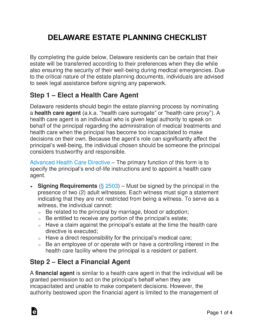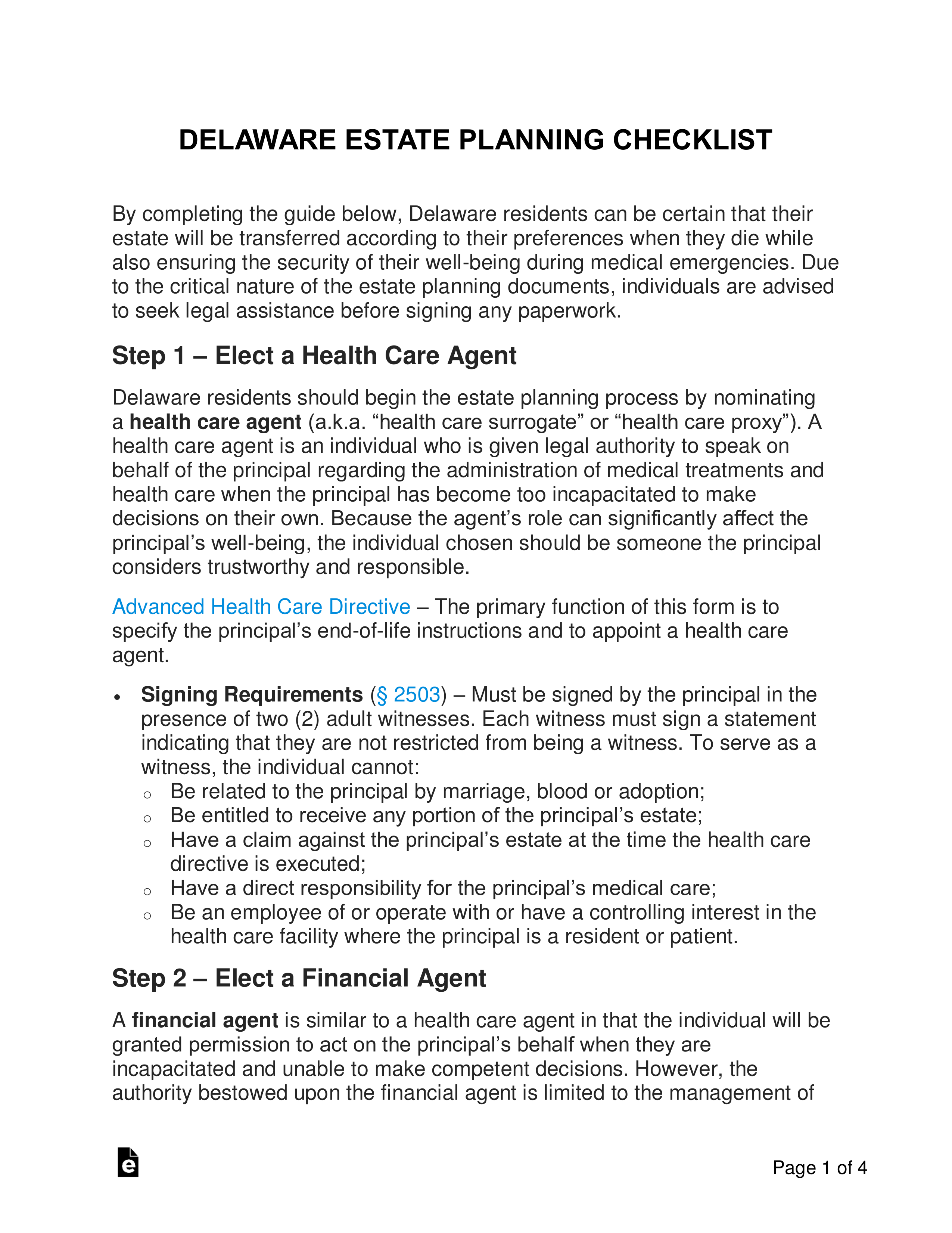Updated March 05, 2024
A Delaware estate planning checklist is a document containing important information for people seeking to secure their personal interests in the event of death or medical emergencies. The party attempting to prepare their estate, referred to below as the “principal,” will have access to the Advanced Health Care Directive and Durable (Financial) Power of Attorney. These documents will protect the principal’s medical and financial preferences should they lose decisional capacity. For the distribution of the principal’s estate upon their death, the individual may complete the Last Will and Testament and, if necessary, a Revocable Living Trust.
How to Create an Estate Plan in Delaware (6 steps)
- Elect a Health Care Agent
- Elect a Financial Agent
- List Current Assets of the Estate
- Communicate with the Beneficiaries
- Make an Estate Distribution Document
- Copy and Store Document
By completing the guide below, Delaware residents can be certain that their estate will be transferred according to their preferences when they die while also ensuring the security of their well-being during medical emergencies. Due to the critical nature of the estate planning documents, individuals are advised to seek legal assistance before signing any paperwork.
1. Elect a Health Care Agent
Delaware residents should begin the estate planning process by nominating a health care agent (a.k.a. “health care surrogate” or “health care proxy”). A health care agent is an individual who is given legal authority to speak on behalf of the principal regarding the administration of medical treatments and health care when the principal has become too incapacitated to make decisions on their own. Because the agent’s role can significantly affect the principal’s well-being, the individual chosen should be someone the principal considers trustworthy and responsible.
Advanced Health Care Directive – The primary function of this form is to specify the principal’s end-of-life instructions and to appoint a health care agent.
- Signing Requirements – Must be signed by the principal in the presence of two (2) adult witnesses. Each witness must sign a statement indicating that they are not restricted from being a witness. To serve as a witness, the individual cannot:
- Be related to the principal by marriage, blood or adoption;
- Be entitled to receive any portion of the principal’s estate;
- Have a claim against the principal’s estate at the time the health care directive is executed;
- Have a direct responsibility for the principal’s medical care;
- Be an employee of or operate with or have a controlling interest in the health care facility where the principal is a resident or patient.[1]
2. Elect a Financial Agent
A financial agent is similar to a health care agent in that the individual will be granted permission to act on the principal’s behalf when they are incapacitated and unable to make competent decisions. However, the authority bestowed upon the financial agent is limited to the management of the principals’ finances. The principal should nominate their financial agent carefully as the individual they choose can make decisions which might greatly affect the value of their estate.
Durable (Financial) Power of Attorney – Allows the principal to both nominate a financial agent and specify the scope of the agent’s authority.
- Signing Requirements – The principal’s signature must be given in the presence of a notary public and one (1) witness who is neither related to the principal by marriage, blood or adoption, nor entitled to receive any portion of the principal’s estate.[2]
Financial Powers Allowed
- Real Property[3]
- Tangible Personal Property[4]
- Stocks and Bonds[5]
- Commodities and Options[6]
- Banks and Other Financial Institutions[7]
- Operation of Entity or Business[8]
- Insurance and Annuities[9]
- Estates, Trusts, and Other Beneficial Interests[10]
- Claims and Litigation[11]
- Personal and Family Maintenance[12]
- Benefits from Governmental Programs or Civil or Military Service[13]
- Retirement Plans[14]
- Taxes[15]
- Gifts[16]
3. List Current Assets of the Estate
4. Communicate with the Beneficiaries
5. Make an Estate Distribution Document
There are two (2) documents to consider when preparing for the transfer of one’s estate after death; a Last Will and Testament and a Revocable Living Trust. Either of the forms may be used in part with the other, though each document serves a slightly different function. The document(s) used by the principal will depend on their financial and personal preferences.
Last Will and Testament (‘Will’) – This form allows for a simplified estate planning procedure. The principal will outline the assets they wish to transfer to each beneficiary and specify other preferences regarding their estate distribution preferences. After the principal dies, the document will go through the probate court which can result in fees and extended processing times.
- Signing Requirements – Must be signed by the principal and two (2) or more credible witnesses.[17]
Revocable Living Trust – Unlike a last will and testament, a revocable living trust will not go through the probate court. The principal may still designate their assets and name beneficiaries. However, upon the principal’s death, the assets can be transferred immediately to the beneficiaries. The downside of a living trust is that the filing process can be more complex and the initial costs are higher.
- Signing Requirements – Should be signed and acknowledged by the principal in the presence of a notary public. Additionally, when a trust is created to transfer assets to another party, and that party will benefit from said assets after the principal dies, the trust must either be:
- Executed by the principal and witnessed by at least (1) disinterested person or two (2) credible persons; or
- Executed by a disinterested trustee who has no concern as to whether the trustor or any other person executed the written trust.[18]
6. Copy and Store Document
Delaware Estate Planning Laws
- Advanced Health Care Directive – Title 16, Chapter 25
- Durable (Financial) Power of Attorney – Title 12, Chapter 49A
- Last Will and Testament – Title 12, Chapter 2
- Revocable Living Trust – Title 12, Chapter 35


